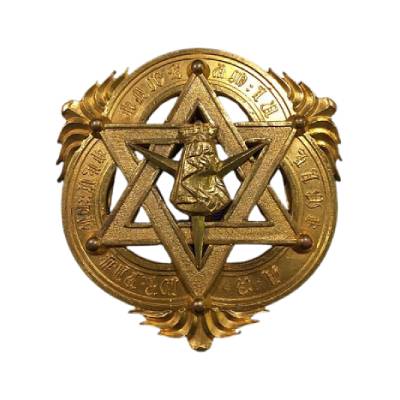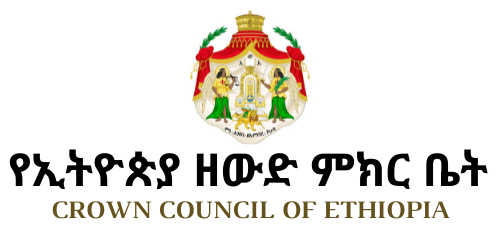
The Order of the Queen of Sheba was established in 1922 during the reign of Empress Zauditu and the Regency of Ras Tafari, but does not appear to have been awarded — or was, at least, little used — until the coronation of Emperor Haile Selassie I in 1930. The Order was originally intended for royal ladies.
“We… had an order with a gold chain made called ‘The Queen of Sheba Order’ which is awarded to the Queen Consort and to foreign queens,” Emperor Haile Selassie said in his memoirs.1Emperor Haile Selassie I: My Life and Ethiopia’s Progress, 1892-1937. Volume One. Translated and annotated by Edward Ullendorf. However, by l950, the Order was being conferred on presidents and prince consorts, usually with a special collar chain. Recipients of the Order with collar include HM Queen Mary (wife of King George V, of the United Kingdom) in 1935, HRH The Duke of Edinburgh of the United Kingdom, President Charles De Gaulle of France, President Dwight D. Eisenhower of the United States, and Emperor Bokassa of Central African Empire. Queen Frederica, of Greece, was invested with the Grand Cross of the Order in 1959, during Emperor Haile Selassie’s visit to Greece.2Greek Ministry of Foreign Affairs Protocol Department archives. HRH Prince Mohamed bin Talal, of Jordan, was invested with the Order by Emperor Haile Selassie. Prince Bernhard of the Netherlands received the Order with Collar.
The sash, star and badge of The Duke of Edinburgh’s Order of the Queen of Sheba is illustrated to the right, in a photograph supplied by Spink, the Queen’s medallists, of London. Spink has made the order, although Arthus-Bertrand has also made it. Significantly, however, new copies of the set have recently appeared at auctions, marked as having been made by the original manufacturer, B. A. Savadjian, in Addis Ababa. The coloured enamelling (noted below) has been absent from the insignia of these sets. This modification was not authorised. It is believed that either incomplete insignia were obtained from Sevadjian’s facilities during the civil war, or from Imperial stores, and never completed. Alternately, it is possible that the original Sevadjian dies have been obtained illegally as a result of the upheaval of the civil war, and that counterfeit copies are being produced.
US President Dwight D. Eisenhower’s Order of the Queen of Sheba may be viewed at The Eisenhower Foundation, in Abilene, Kansas, in the US.
The Order continued to be conferred, as well, on female royalty: princesses of the Imperial Family and foreign princesses. In recent years, the Sheba has been given to dignitaries of the level of Governor-General in some Commonwealth states.
The order today comes in one class, and the insignia comprises a Star of David around a bust of the fabled Queen, enamelled in emerald and amethyst colours. The sash is deep violet with border stripes of emerald green.
Before World War II, the Order was listed fifth in order of precedence, after the Orders of Solomon (which subsequently became two separate orders), the Trinity, Menelik II, and the Star of Ethiopia. Today, it clearly ranks third in precedence after the Order of Solomon and the Order of Solomon’s Seal. As well, when it was created, the Order of the Queen of Sheba was issued in five grades: Grand Cordon (or Grand Cross) of the (Order of the) Queen of Sheba; Grand Officer; Commander; Officer; and Member or Chevalier.3Zervos, A. Op Cit. No records can at present be obtained as to whether the Order was ever presented in other than the Grand Cross form, but it is possible that some records still exist in the archives which remain inaccessible in Addis Ababa.
It is possible that the Order of the Queen of Sheba may have had its origins in, or taken inspiration from, the Ethiopian Order of the Red Cross, founded by the Empress-consort (Itegé Taitu) in 1901-1902.4Montandon, Op Cit. Page 412. The insignia of the Order of the Red Cross was, like the Order of Solomon, based on the Star of David (two overlapping triangles), although the Red Cross was in silver; the Sheba in gold. The Order of the Red Cross had the red cross of St. George superimposed upon it; the Sheba has the visage of the Queen of Sabæ superimposed.5Later versions of the Order of the Red Cross were different: the Order showed the Red Cross with the Imperial Lion of Ethiopia across it, and with the Imperial Crown atop the cross. Source: HH Prince Asfa-Wossen Asserate.
Holders of the Order of the Queen of Sheba may use the post-nominal initials GCQS (Grand Cross of the Order of the Queen of Sheba).


